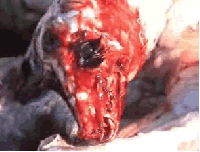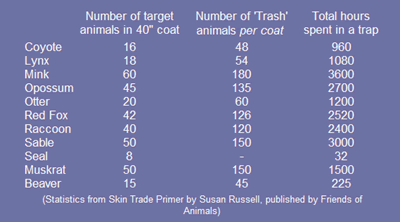Face the Truth - Fur
by Ruby Lawrence
"The deliberate killing of any living creature, not because someone is hungry or cold, but merely for luxury or adornment, is morally unacceptable." -Richard Adams, author of Watership Down
As wise as Adam's words are, they seem to be forgotten by clothes shoppers everywhere. The demand for animal skin, particularly fur, is on the rise, mostly due to the increase in its appearance on the catwalk and on the pages of glossy fashion magazines. Each year, the worldwide fur industry kills more than 55 million animals in the name of fashion.1 Shoppers treating themselves to a new fur coat or scarf fuel the cruel, tortuous murder of innocent creatures across the globe. This has to stop.
Eighty-five per cent of the world's fur originates from farms.2 The most commonly bred animals are fox and mink, with other species including chinchilla, raccoon dog, polecat/ferret, and coypu. No matter how "humane" a company claims its skinning process to be, no method is pain-free. Killing procedures vary between and within species. Common fur-farm slaughter methods include electrocution - where electrodes are clamped in the animal's mouth and inserted into the rectum - neck snapping, gassing, and lethal injection. The priority of the fur farmers is to keep the pelt of the animal intact, hence the excruciating insertion of electrodes into areas like the mouth and rectum, where the fur will not be damaged. No anaesthetic is used. The terror and pain they suffer is unimaginable.
Animals slaughtered in this way are the lucky ones however. A report into Chinese fur-farms revealed that a significant number of animals remain fully conscious during the process of removing the fur.3 These creatures are actually skinned alive.
 Racoon Dog alive and fully conscious after skinning, dumped on a pile of the corpses of its own kind. Chinese fur-farm.
Racoon Dog alive and fully conscious after skinning, dumped on a pile of the corpses of its own kind. Chinese fur-farm.
Before the hideous killing and skinning process, the animals have already undergone weeks of torture. PETA published the following report following their investigation into Chinese fur-farms, which supply more than half the fur garments for sale in the US.
"On these farms, foxes, minks, rabbits, and other animals pace and shiver in outdoor wire cages, exposed to driving rain, freezing nights, and, at other times, scorching sun. Mother animals, who are driven crazy from rough handling and intense confinement and have nowhere to hide while giving birth, often kill their babies after delivering litters. Disease and injuries are widespread, and animals suffering from anxiety-induced psychosis chew on their own limbs and throw themselves repeatedly against the cage bars."4
The animals born and raised in shockingly cramped fur-farm cages know nothing but mistreatment and pain from birth. However, many animals are still trapped and caught in the wild, forced from their natural environment. Sickeningly, many of these are endangered or critically endangered species, being butchered one by one in the name of fashion. An extract of a table from the HSUS (the Humane Society of the United States) shows an annual estimate of just some of the animals killed for fur, including those taken from the wild.5
Legholds, Conibear traps and snares are non-selective killing devices, which means that there are many "non intended" animals who get caught in these barbaric contraptions. These traps are banned in 88 countries, but leghold traps are still widely used in the United States and Canada. They are spring-loaded steel jaws which clamp shut on an animal's foot once sprung. There are common cases of animals driven to frenzied madness from the pain, actually ripping themselves free from the trap and completely severing a limb by chewing it off. Imagine the raw desperation of a creature in this situation. Conibear traps are square or rectangular "scissor-action" traps in which an animal passing through the middle is caught as the two sides are snapped together. Snares are wire strangulation noose that tighten around an animal's neck or body. They are usually used underwater to drown animals or are attached to fences to hang them.
And don’t forget it takes more than one animal to make a fur coat; purchasing just one animal skin funds the death of dozens of animals.
I think it is time the world realises that commerce is no excuse for murder and suffering. Instead of buying into an industry of torture, shoppers can easily opt for something pain-free and equally fashionable. Don’t be tempted by big names like Gucci or Prada; remember that behind their "beauty" is hidden a messy and brutal slaughter. There is nothing beautiful about wearing the skin of animals that have suffered a life of misery. Feel comfortable in your own skin, and leave them theirs.
"Our task must be to free ourselves... by widening our circle of compassion to embrace all living creatures and the whole of nature and its beauty." - Albert Einstein
December 13, 2008
References
- Data from the Kopenhagen Fur Auction, IFTF, the US Fur Commission & Statistics Canada
- International Fur Traders Federation
- Fun Fur - a report on the Chinese fur industry. Care for the Wild et al. 2005
- www.peta.org/feat/chineseFurFarms/index.asp
- www.hsus.org/furfree/news/how_do_fur_animals_die.html


![Seal - source: stopthecanadiansealhunt@groups.care2.com [ 29.62 Kb ] Seal - source: stopthecanadiansealhunt@groups.care2.com [ 29.62 Kb ]](/data/image_1_4417.png)